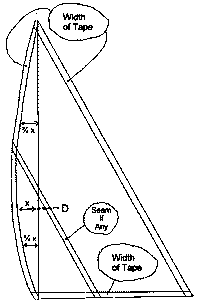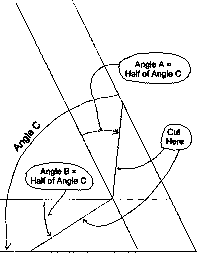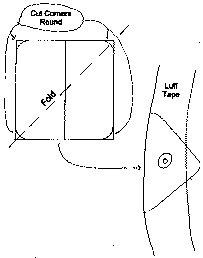As you travel around near where you
live, keep your eyes open for a house being built. The odds are that,
after the walls have been sheathed with plywood, but before it has
been covered with the finishing surface of shingles or clapboard or
brick or whatever, it will be covered with looks like white paper.
On the paper, in big blue and red letters, are printed “TYVEK” and
the DuPont logo.
Or you may have received things in the mail in a big white
envelope that you discover you can't tear open, for it is too
tough. And you may see workmen handling chemicals clad in white
suits. These too are made of Tyvek.
You can make a good sail out of it, and very easily and
cheaply.
In the first place, it is available in great width. What
the house builder uses is typically ten feet wide. So there will
be fewer seams, and in a small sail, no seams at all.
In the second place, it doesn't need to be stitched.
Wherever one piece of cloth goes over another, like at a seam or
a corner reinforcement, it can be stuck together with tape.
Start by going by where such a house is being built, tell
the boss you want to make a sail, and ask him to sell you some
material. Odds are he'll be interested, and will give it to you.
You're going to get a sail that has blue and red advertising
on it, but it is a conversation piece, and you'll have lots of
fun talking about it to other sailors, and they will come away
convinced of what a clever fellow you are.
You will need to go by the hardware store and buy the tape.
What you want is found in the garden shop, and you will be asking
for the tape, sticky on both sides, that is. used for holding down
outdoor carpet. Get wide stuff- it can be had as much as two
inches wide. And don't be afraid if the material looks like
cheap paper, that might rot. It is mighty tough, designed as it
is for the job it does...
While you are there pick up two grommeting kits, one for
small grommets to attach slides or spar lashings, and another for
larger grommets, for corners.
Now plan the sail. For this first sail, let's not have
battens; they would complicate things a lot. Draw a picture of
it, and figure out if you can make the sail without a seam.
Remember, as you draw it, there will be curve to the luff, to.
shape the sail. And also, at each edge the sail will be two
inches wider, for the taped hem. If you do need a seam, plan to
use the edge of the material at the leach, and run the seam
parallel to the leach, as in the sketch. Located in this way the
force across the seam, tending to pull it apart, is kept at a
minimum.
Let's make the leach and foot absolutely straight, unless
the foot is to be attached to a spar. But any edge attached to a
spar needs to be curved in order to get shape into the sail. The
deepest part of the curve, for a reasonably stiff mast, ought to
be one third of the way up the luff from the tack, and its depth
should be one inch for each five feet of luff (or foot). By the
way, for now let's call that point “D” for now. More about it
later.
Now you need a gym or a dance floor, or something like that.
You can guarantee the owner that you will not harm it. And you
and your helper, if you have one, will for sure need a set of
knee pads, like volleyball players and flooring people use, or
you will come away with sore knees.
Be sure the floor is really clean, and not dusty.
Lay out the material, and cut it roughly to shape, leaving
maybe a foot of excess along the luff and foot. Now lay it down
again and use bits of masking tape to hold it stretched out. If
your sail is to have a seam, stick down only the large panel. Do
not, by the way, use a lot of force; you don't want to stretch
the material. Now apply the tape to the edge where the seam is
to be. This requires a lot of concentration, and is high
precision work; take your time. The tape is really sticky;
mistakes are hard to correct. Do not stretch the tape; if you do
you will get a puckered seam.
Now get the next panel handy, peel the backing off the tape
you have already laid on the other panel, and attach it. Also
tricky.
Tape down what you have on the floor. Remember, minimum
tension, just enough to hold it smooth.
I hope you were able to find a long, flexible batten, and
also a long straightedge. With a little ingenuity and much
cussing I was able to make do with an eight foot by one inch
strip of aluminum that you can find in any hardware store, but
maybe you do better than that. Draw straight lines for the foot
and the leach, and also straight lines parallel to them and
outside them by the width of the tape.
Locate Point D and mark it.
 For bending the batten and holding it in place so that you
can draw the curve of the luff, you can use. bricks, cans of
paint, heavy books or lots of light ones. But be wary of this:
the batten will tend to bend much more at Point D than elsewhere
if you just pin it down at head, tack, and Point D, giving you a
curve the is not fair. The batten wants to be bent outward just
a little bit more, halfway between Point D and the corner. Do
it.
For bending the batten and holding it in place so that you
can draw the curve of the luff, you can use. bricks, cans of
paint, heavy books or lots of light ones. But be wary of this:
the batten will tend to bend much more at Point D than elsewhere
if you just pin it down at head, tack, and Point D, giving you a
curve the is not fair. The batten wants to be bent outward just
a little bit more, halfway between Point D and the corner. Do
it.
To do a perhaps better job than you can do by eye, you might
want to mark a couple of more points on the curve. Try this.
Halfway from Point D to each corner, measure out from the
straight line a distance equal to 3/4 of (or .75 times) the
distance you measured out to find Point D. This will give us a
really good approximation of an arc of a circle, in curves of the
dimensions we are using.
Draw the curve. Draw also a line, like before, outside it a
distance from it equal to the width of the tape.
Now you have the choice of attaching the tape to the edge
and then cutting off the excess Tyvek, or cutting along the
pencil line followed by taping. I say cut first. This can be
done best with good, big, sharp scissors.
Tape the sail back down onto the floor. It now does look
like a sail, doesn't it?
Apply tape to the edges. Getting it smoothly onto a curved
edge will make you really appreciate the knee pads.
The next to the next step will be pulling the backing off
the tape and folding it over. But this will produce an unsightly
and hard to work with lump at each corner where the tapes overlap
unless we prevent it.
 Here you need a protractor- an angle measuring device. Less
than a dollar at any store that has school supplies.
Here you need a protractor- an angle measuring device. Less
than a dollar at any store that has school supplies.
Measure the angle at a corner. This is shown as angle C on
the drawing. You want to cut off the tape so that the angle you
are cutting is half this. These angled are shown on the sketch
as angles A and B. Suppose the angle is seventy degrees: divide
this number by two. Thirty-five degrees out from the corner,
along the edges, is where you mark a line- shown on the sketch as
a dotted line- and make your cut. The drawing may make this bit
more clear.
By the way, do not cut tape with the scissors, if you can
avoid it. The adhesive will gum up the blades. in no time. The
right tool is an something like an Xacto knife.
Now do this slowly. You are going to peel the backing off
the tape, and fold it over to make the hem. Once again be sure
that there is no dust or dirt around. Do not peel all the
backing off at once. Peel it back maybe three feet, fold and
stick down, peel off more and stick down more....
You are going to be delighted, at this stage of the game, to
find that the luff is really easy, in spite of the curve. And
the corners are really neat, because of what you did in the
previous step.
 The corner reinforcements are no big deal, but they are a
lot of nit picking work. Make them triangles- probably three at
each corner will be enough- each one bigger than the next, and
each one oversized along the edges of the sail. Cover them
completely with tape, and stick on the small one, then the next
one, then the largest. Then cut them to size with the knife,
bang in the grommets and round the corners.
The corner reinforcements are no big deal, but they are a
lot of nit picking work. Make them triangles- probably three at
each corner will be enough- each one bigger than the next, and
each one oversized along the edges of the sail. Cover them
completely with tape, and stick on the small one, then the next
one, then the largest. Then cut them to size with the knife,
bang in the grommets and round the corners.
Reinforcements are in order at each point where you are
going to put in a lashing or attach a slide. Two strips of tape,
side by side on the material, will give you a strip three or four
inches wide, and you can cut it into three or four inch squares.
Cut the corners slightly round, or they will tend to come
unstuck, and bend them around the edge of the sail, the diagonal
along the luff, forming triangles. Cut your holes and bang in
grommets through the three layers of material and three layers of
tape.
If you want reefs or a headboard, use your imagination and
experiment.
Now you have a sail, and it is stronger and will set better
than you think, by a lot.
And now be sure that you haven't left anything sticky on the
floor of the ballroom- you will want to use it again. Masking
tape leaves little goo behind it, but be sure.
Take pictures of your boat sailing under your creation, and
give one to the guy who gave you the material, and also one to
the guy who runs the ballroom.
A Few Cautions
You will hate the sound of the sail luffing- it sorts of
makes a rattling sound, it doesn't sound like a sail at all. But
you will grow accustomed to it, especially as you check your bank
balance.
Don't attempt to strengthen this sail by running the seams
and edges through a sewing machine. The stickum on the tape will
gum up the needle immediately. If you really want to sew the
seams, make them a lot wider than the tape and sew through the
Tyvek, but not through the tape. Any batten pockets you may want
should probably be stitched.
The material is rather stretchy. It isn't as bad as the
light nylon they use to make sails for boats like a Sunfish, but
it is nowhere nearly as inelastic as Dacron. When it is blowing
hard the sail will get slightly more full.
It turned out that the mast I made was a lot bendier than I
had expected, and in any breeze at all the sail looks lousy-
although it sure does drive the boat. On my next sail I am going
to move Point D farther up the luff and make the curve deeper.
Likely you will do something like that, too.
From making the first sail you will learn a lot about making
the next sails better and faster and more easily. And you will
probably want to start by calling up DuPont and asking for sample
materials and prices. They make the material in a lot of
different weights and textures, and different widths. But you'll
have to buy a lot of it, probably a roll of at least a hundred.
feet; it is still very cheap, however.
I have no idea how big a sail can be made in this way and
still not blow apart. Bernie Wolfard writes of a 40+ foot
schooner with Tyvek sails as big as 300+ square feet.
Reinforcements could be bigger, seams could be made of two widths
of tape, etc. And it is a truly minor disaster to have such a
sail blow apart, most of the time. Have oars or a motor....
This is going to be cheap and fun and interesting. Set about
it.
 Back to John's Nautical Page
Back to John's Nautical Page

 Back to John's Nautical Page
Back to John's Nautical Page
